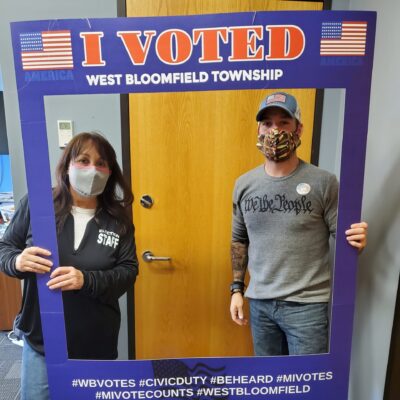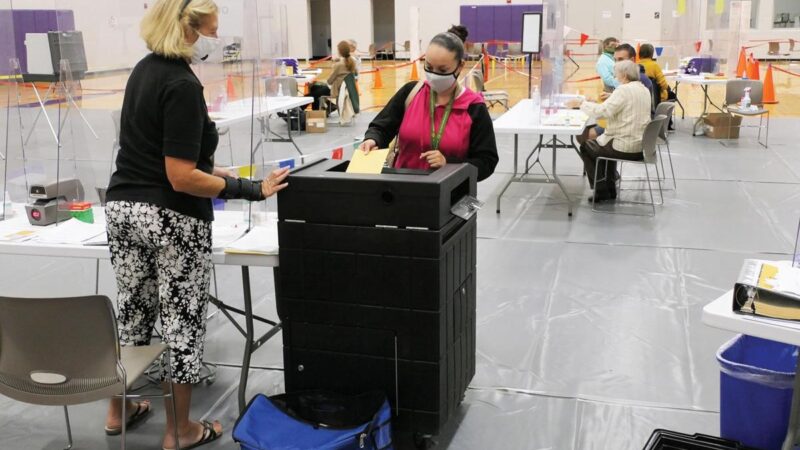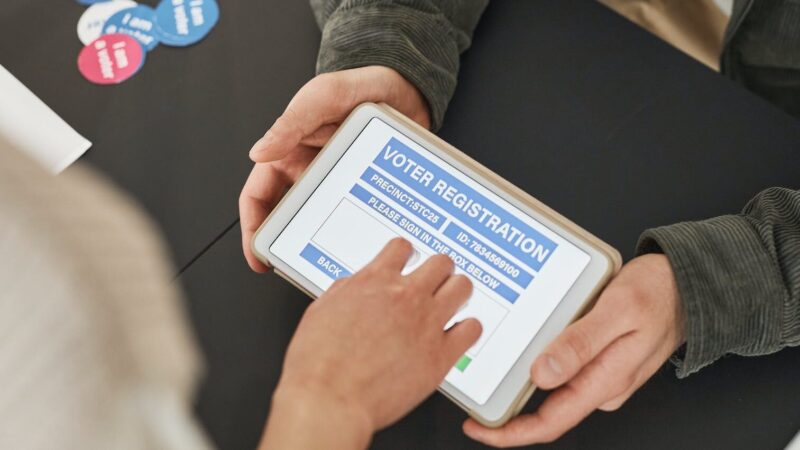RFP how-to guide for election officials
Guidance to help you write a successful request-for-proposal document.

What you’ll need
- Details about your procurement needs: approved budget, timeline, hardware and software requirements, etc.
- Word processing program (e.g., Microsoft Word, Google Docs)
Getting started
Getting your RFP right is critically important.
You need to be responsible and transparent about spending public funds. You need to make sure your team gets the right materials. Plus, you’re laying the foundation for a vendor relationship that could involve millions of dollars and last for years.
1. Webinar
Looking for an overview? This webinar outlines best practices for creating an election RFP and provides an introduction to this how-to guide.
2. FAQs on RFPs
Ready to learn more about RFPs? Here are some FAQs to help you get started.
What is an RFP?
An RFP is an invitation to vendors or service providers to provide you with a product or service. An election authority uses an RFP when it wants to do things like purchase or update its election management system, buy or lease voting equipment, or have ballots printed or delivered.
It’s a bit like working with a real estate agent to find a house. You start by telling your agent what kind of house you want, which neighborhoods you like, and then provide details about must-haves (close to public transit) and nice-to-haves (a fenced-in yard) for your new home. She’ll respond with several properties that meet your guidelines, and you can choose which one you like best and can afford.
In a similar way, an RFP explains what equipment, materials, or services you’re looking to buy, and vendors will respond with bids explaining how they can meet your needs. You then review the bids to decide which is the most promising.
How is an RFP different from an RFI or RFQ?
RFPs are similar to requests for information (RFIs) and requests for quote (RFQs). All of these invite vendors to submit information to help guide purchasing decisions, but each is a little different. The one you use depends on your situation.
- The RFI is the most open ended of the three. In an RFI, you explain a problem or challenge and invite vendors to suggest products and services to address it.
- With the RFP, you have a clearer sense of what you want to purchase and its specifications, and you simply invite different proposals to meet your needs.
- The RFQ is the most restrictive in terms of how bidders may respond. With an RFQ, you know exactly what you want and are mostly seeking price information so you can identify the lowest bidder.
RFPs are probably the most commonly used genre in election procurement, and that’s why we focus on them here.
For more information about RFIs, RFQs, and related documents, read this helpful article by Arin Dey.
What makes an RFP good or bad?
As a general rule, the more specific an RFP is, the better.
State goals in detail, without being afraid of getting into the weeds. Ask bidders to be detailed in their responses, too.
Check out the examples below regarding expectations of compatibility.
Good: The proposed voting system should be compatible with modern e-pollbooks.
Better: The proposed voting system should be compatible with the county’s existing E-ZCheck Poll Pads.
Best: Bidders should describe how their proposed voting system is compatible with the county’s existing E-ZCheck Poll Pads without loss of any system features.
How long should our RFP be?
There’s no right or wrong in terms of length; RFPs can be 1 page or 100 pages long.
Larger election authorities often produce longer RFPs than smaller authorities because they have more developed and specific procurement guidelines. If your needs are simple, your RFP can be brief.
What information is necessary to get started?
To get started with an RFP, you need some key pieces of information:
- Budget: Normally, you won’t actually name your budget in the RFP. But it’s important to know as you prepare because it will determine the expectations that you state in the document. If you’ve got $3,000,000 to spend, you can have much higher expectations than if you have $500,000.
- Scope of work or scope of services: When you think of scope, make a list of must-haves and nice-to-haves for what you’re buying.
- Timeline: Keep in mind that it’ll take months for your office to get from the RFP to the stage where you’re actually using what you’ve purchased. So, get started early.
- Laws: What federal, state, and local laws and regulations will your office — or your potential vendors — need to follow? From EAC certification to economic disclosures, you’ll need to collect information about laws related to your purchase.
Can you start drafting an RFP if your office leadership is still making decisions about things like budget and timeline? Absolutely.
Just be aware these matters will need to be settled before you can finalize the RFP.
Who should be involved?
An RFP isn’t a one-person job.
Creating an RFP, reviewing bids, and making a purchase will require contributions from a number of different people and departments in your government. In addition, your procurement may impact stakeholders outside of your office, like advocacy groups, political parties, and voters with disabilities. They should be involved, too.
That’s why it’s a good idea to form an RFP committee or task force.
Create a list of people you think should be involved. If your jurisdiction has a purchasing agent or a procurement team, start with them. Also be sure to involve someone from your legal team. Then, continue to invite first internal and then external stakeholders.
When you invite them, be clear about the contributions you want from them, and explain roles, expectations, and timeline so that your process goes smoothly.
How will we evaluate submissions?
To assess submissions, you’ll want to create a rubric. Once you have a set of selection criteria, you can make these criteria into a simple rubric by assigning scores based on the extent to which a proposal meets each criterion.
For instance, you can take the compatibility criterion mentioned above and transform it into a line item on a rubric like this:
Criterion: “Bidders should describe how their proposed voting system is compatible with the county’s existing E-ZCheck Poll Pads without loss of any system features.”
Rubric line item: Did this bidder describe how their proposed voting system is compatible with the county’s existing E-ZCheck Poll Pads without loss of any system features?
(Select 1 — worth up to 2 points)
- 0: Proposal does not describe compatibility or says the system is not fully compatible
- 1: Proposal says system is compatible but is unclear about the details
- 2: Proposal is clear about the system’s compatibility without loss of features
Using the tool
Once you know the basics about your procurement plan, you can start drafting your RFP.
The instructions below discuss what content to include in your RFP, how to distribute it, and how to begin the process of assessing submissions.
Assembling your RFP1. Assembling your RFP
What should your RFP include? This section gives an overview of the most common sections found in an election RFP. These sections are already included for you to customize in the RFP template.
To help you see what kind of information to put in each section, we provide examples from sample election RFPs. If you want to see the entire sample RFPs, they’re cited in the list of resources at the bottom of the page.
As you look at these sections, keep in mind that different RFPs use different terms. A section that one calls “goals” another may call “scope of work,” “specifications,” or “scope of services.” The ideas are more important than the specific terms used.
Cover page or cover letter
RFPs often include a cover page with the election authority’s name, a title for the RFP (e.g.,“Provision of Ballot Printing to the County Clerk”), contact information, and important dates. Deadlines for submitting proposals and for submitting questions may also be stated here.
This information can sometimes take the form of a press release, public notice, or cover letter, complete with greeting and closing signature.
A 2018 RFP from the Mercer County, New Jersey Clerk uses a pretty standard cover page.
Definitions
You may wish to define terms that will appear in your RFP. This helps clarify expectations and allows you to use shorthand terms to save time and space.
A 2014 RFP from the Pinal County, Arizona Elections Department includes a page of definitions.
Although a section on definitions often appears at the beginning of an RFP, some RFPs instead include definitions as an appendix.
Overview
Sometimes called “background” or “introduction,” this is normally the first prose section of your RFP, and it should describe your jurisdiction, give a sense of how elections are run there, and explain why you’re issuing the RFP.
Introduce your town, county, or state the way you would to someone who had never visited there before. Include data like the number of registered voters, number of precincts or polling places, and the current equipment you’re using.
A 2017 RFP by the Chicago Board of Election Commissioners includes an overview section called “Introduction and background.”
Goals, scope of work, or scope of services
In this section, state the outcomes you hope to get from the procurement process. Think to the future and consider what you’ll have if your process is successful, remembering to be as specific as possible.
The Pinal County RFP includes a concise statement of goals.
An RFP from the Boone County, Missouri Clerk covers objectives in a “scope of services” section.
System requirements and specifications
Whatever you’re purchasing will need to meet specs. In this section, provide details related to hardware and software requirements, state and federal certification, and compliance with the Americans with Disabilities Act.
A 2018 RFP from the Woodbury County, Iowa Commissioner of Elections includes sections on “equipment requirements” and “software requirements.”
In some cases, you may mention plans for testing specifications.
Deliverables 1: initial setup
You should divide deliverables into two sections. In the first, list services related to initial setup of what you’re purchasing. These commonly include things like removing old equipment, delivering new equipment, testing it, and training staff on it.
Woodbury County’s RFP gives requirements for removing old equipment, delivering the new equipment, and training staff.
Deliverables 2: ongoing maintenance
In a second section on deliverables, focus on services related to ongoing maintenance of what you’re purchasing. This’ll likely include a plan for service and support as well as updates or upgrades to extend the usability of what you’re purchasing.
Boone County’s RFP has sections on “warranty and maintenance,” “support,” and “modification and upgrades.”
Requirements of all vendors
Here, name requirements that all vendors need to meet in order to be considered.
It’s common to cover requirements related to record retention, minimum wage and affirmative action practices, financial audits, and confidentiality. Information about liability and insurance coverage shouldn’t be included here but should go later, in a different section.
Pinal County’s RFP has a simple section called “contract administration and operation.”
Chicago’s RFP covers vendor requirements in several sections that are organized by topic.
Questions for vendors
Your RFP may include prompts that you want bidders to respond to in their submissions — a bit like questions you might ask in a job interview.
The Mercer County RFP asks respondents to draft an executive summary.
Woodbury County’s RFP asks bidders to submit a “company vision.”
Submission instructions
It’s vital to be clear about how bidders should submit their proposals. This information will include details like the date and time for the deadline (remember to provide the time zone), the format for submissions, and the number of copies required.
If your vendors must register with an online system or attend a vendor’s conference, explain the process.
It’s common to invite potential bidders to submit questions or clarification inquiries, and you can include instructions for doing so here.
The RFP from Pinal County gives instructions in sections labeled “offer preparation” and “submission of offer.”
Boone County’s RFP gives guidelines on how to organize proposals and who to contact with questions.
Selection criteria
After giving submission instructions, explain how the selection process will work. Talk about your evaluation criteria, the process, and the timeline.
Woodbury County includes a simple, bullet-point list of selection criteria in its RFP.
If you want to be especially transparent, you may choose to even include the rubric that you’ll use to score submissions.
Legal statements including insurance liability
Near the end of your RFP is where you include legal statements. This information usually isn’t up to your discretion but is instead required by local or state law.
If you have affidavits for bidders to complete, save those for later. They should go in an appendix section.
The legal section of Pinal County’s RFP is focused on insurance and bond requirements.
Boone County’s RFP has a legal section that talks about patents, a state domestic purchasing policy, insurance liability, and more.
Checklist for responders
To help bidders ensure that they’ve met your submission requirements, you may include a checklist. It can save you the headache of dealing with incomplete submissions.
Mercer County includes a proposal checklist for responders.
Attachments or appendices
Most RFPs include forms, affidavits, spreadsheets, and other materials as attachments or appendices. You may want to provide a W-9 form, required affidavits (for instance, a certification of non-collusion), cost breakdown spreadsheets, and similar documents.
If you have detailed worksheets or rubrics that are part of the proposal process, include those here, too.
Woodbury County’s RFP has a cost breakdown sheet and a public hearing notice as attachments.
Chicago’s RFP provides forms and affidavits as appendices.
2. Using an RFP template
To help you create your RFP, we’ve made a template to download and customize. The template includes a cover page, table of contents, section headings that mirror the structure described above, and placeholder text you can modify.
The template is a .docx Microsoft Word file. To use it, you can open the file in Microsoft Word or upload it to Google Docs and begin editing.
Reviewing your RFP draft3. Reviewing your RFP draft
Once your RFP is drafted, share it with others to get feedback.
First, show it to your legal team for review. Making sure your RFP incorporates legal requirements is critical.
Next, if you’ve put together an RFP committee, plan a meeting in which participants can ask questions and give feedback. You can guide the discussion with prompts like these:
- What do you like about the RFP?
- What do you think might be missing?
- To what extent does the RFP reflect the needs of your department, advocacy groups, or the community?
- What questions do you think we might get from bidders? How could we change the RFP to address them in advance?
Get feedback from your stakeholders and, where appropriate, adapt your RFP to address their suggestions.
4. Distributing your RFP
Some government entities have clear requirements for publishing RFPs. If so, follow them.
If your options are more open, consider sending the RFP to vendors you know who provide relevant products and services. If you’re not sure which vendors to send it to, you can ask your state election authority or your state association.
Keep in mind that just because you send vendors an RFP doesn’t mean they’ll respond to it. The application process takes considerable time and effort for vendors (20-50 hours of work is not uncommon), and they might not want to make the investment.
And remember that one of the most common responses you’ll get to an RFP isn’t a proposal but rather a list of questions. Make sure to set aside time to field these questions.
5. Reviewing bids
After your RFP submission deadline has passed, you can start your selection process.
First, flag any proposals that don’t meet your posted requirements. You may allow these bidders to revise and resubmit their proposal, or you may not.
With the remaining bids, have your selection team members score submissions using the rubric that you created. Hold a meeting to share scores and move toward an ultimate decision.
Once you decide on a bidder, the next step is to create a contract with your legal team. Congratulations on your progress!
Resources
Voting system technical guidance for election RFPs
Center for Internet Security: “A Guide for Ensuring Security in Election Technology Procurements”
https://www.cisecurity.org/wp-content/uploads/2019/05/CIS-Elections-Procurements-12-April.pdf
Election Assistance Commission: “Managing Election Technology”
https://www.eac.gov/voting-equipment/managing-election-technology/
National Institute of Standards and Technology: “Cast Vote Records Common Data Format Specification”
https://pages.nist.gov/CastVoteRecords/
National States Geographic Information Council: “HAVA Funds for GIS”
https://elections.nsgic.org/hava-funding-gis/
Research on how to write RFPs
Arin Dey: “Are You Confused with the Terms RFI, RFQ, RFT, and RFP?”
https://medium.com/@arindey/are-you-confused-with-the-terms-rfi-rfq-rft-and-rfp-478a43f721d2
Tabitha Lehman: “How to Write a Successful RFP” (Unpublished presentation — Kansas County Clerks and Election Officials Association 2017 Annual Conference — Manhattan, Kansas, May 2017)
Jami Oetting: “The Ultimate Guide to RFPs.”
https://blog.hubspot.com/marketing/rfps
Information about local government purchasing co-ops
OMNIA Partners: “U.S. Communities Is Now OMNIA Partners, Public Sector”
https://www.omniapartners.com/publicsector/us-communities-an-omnia-partner
RFP examples referenced here
Boone County, Missouri Clerk: “Request for Proposal for Voting Systems” (2018)
Chicago, Illinois Board of Election Commissioners: “Request for Proposals (RFP): Voting System” (2017)
Mercer County, New Jersey Clerk: “Provision of Ballot Printing, Vote by Mail Envelopes, and Applications for the Primary, Special, and General Elections for the Mercer County Clerk for Two (2) Years with One (1) Year Option to Extend” (2018)
Pinal County, Arizona Elections Department: “Notice of Request for Proposal: Elections Equipment and Maintenance” (2014)
Woodbury County, Iowa Commissioner of Elections: “Request for Proposal (RFP): Voting Equipment, Software, and Services” (2018)


